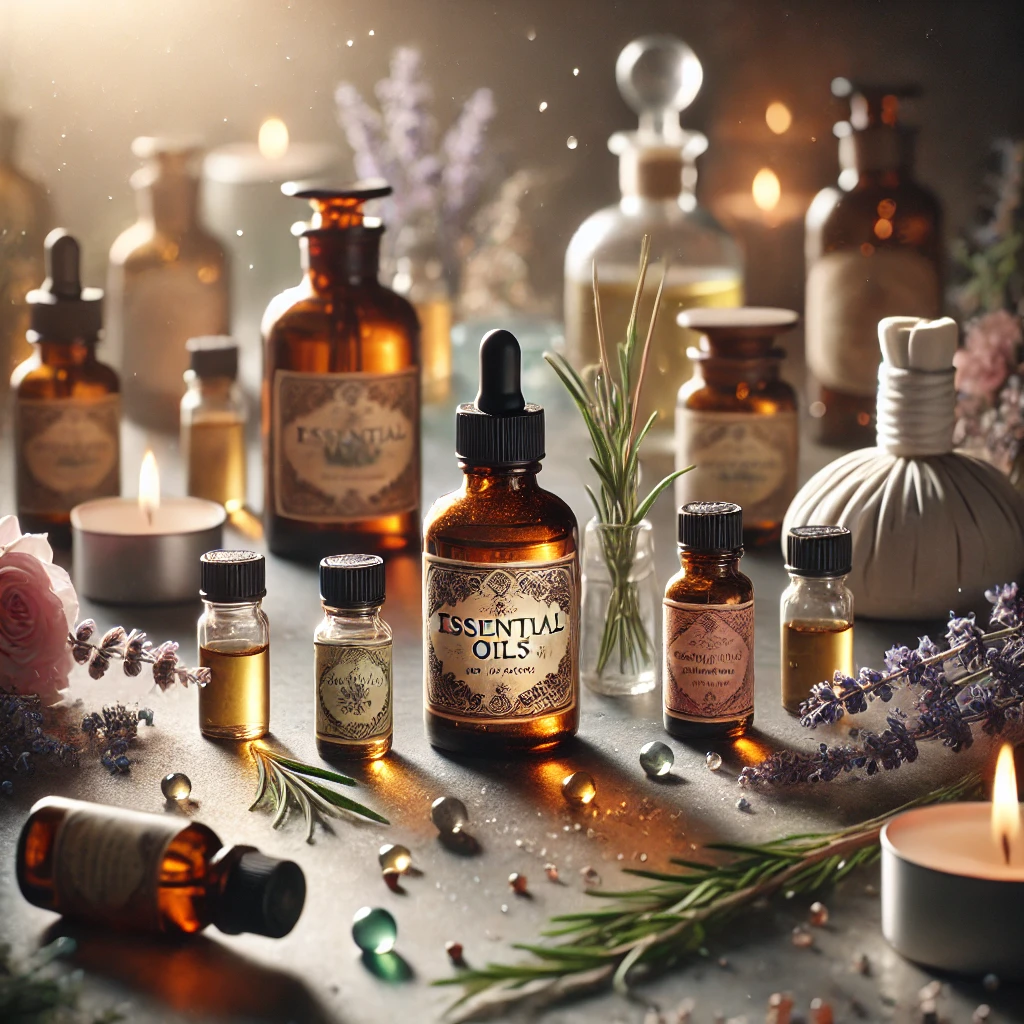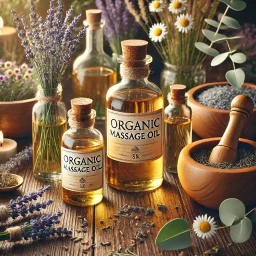
Essential Oils for Massage: Top Blends and Recipes for Relaxation and Pain Relief
1. Introduction to Essential Oils for Massage
Essential oils have become a cornerstone of massage therapy, offering a holistic approach to wellness by combining the benefits of physical touch with the therapeutic properties of plants. These concentrated extracts from flowers, leaves, bark, and roots are not only popular for their aromatic qualities but also for their ability to promote relaxation, alleviate stress, and enhance the overall massage experience.
Key Points to Include:
What are Essential Oils?
Essential oils are volatile, aromatic compounds extracted from plants through methods like steam distillation or cold pressing. They capture the plant’s scent, flavor, and therapeutic properties in a concentrated form.
Why Use Essential Oils in Massage?
Essential oils are used in massages to enhance relaxation, reduce tension, alleviate pain, and improve mental clarity. Their therapeutic effects are achieved through both inhalation and topical application during massage, making them a powerful tool in holistic healing.
Key Benefits of Using Essential Oils in Massage Therapy:
Enhances Relaxation: Oils like Lavender, Chamomile, and Ylang Ylang promote a calming atmosphere, reduce stress, and improve sleep quality.
Alleviates Pain and Soreness: Oils like Peppermint, Eucalyptus, and Rosemary help relieve muscle tension, reduce inflammation, and soothe sore joints.
Improves Skin Health: Many essential oils, such as Tea Tree and Frankincense, have antibacterial, anti-inflammatory, and regenerative properties that can benefit the skin.
Importance of Choosing the Right Essential Oils:
The effectiveness of a massage greatly depends on selecting the appropriate essential oils for specific needs, such as relaxation or pain relief. Choosing the right oils ensures that the massage not only feels good but also provides the desired therapeutic benefits.
2. How Essential Oils Work in Massage Therapy
Essential oils work in massage therapy by engaging both the olfactory system (sense of smell) and the skin. When essential oils are inhaled or absorbed through the skin, they interact with the body’s systems to promote physical and emotional well-being.
Key Points to Include:
The Science Behind Essential Oils in Massage:
When essential oils are applied to the skin during massage, their active compounds penetrate the skin and enter the bloodstream. The skin is the body’s largest organ, and it efficiently absorbs these compounds, allowing them to provide localized effects (e.g., reducing muscle pain) and systemic effects (e.g., promoting relaxation).
The Role of Aromatherapy in Massage:
Aromatherapy, a key component of massage therapy with essential oils, involves inhaling the aroma of oils. The olfactory system is closely connected to the limbic system, which is the part of the brain that controls emotions, memories, and arousal. When essential oils are inhaled, they can influence mood, reduce stress, and evoke positive feelings.
Physical and Psychological Benefits:
Physical Benefits: Relieve muscle soreness, reduce inflammation, improve circulation, and promote detoxification. Oils like Eucalyptus and Peppermint are particularly effective in alleviating muscle tension and joint pain.
Psychological Benefits: Essential oils such as Lavender and Bergamot can help reduce anxiety, lift mood, and improve mental clarity. This dual action (physical and psychological) makes essential oils incredibly effective in massage therapy.
Effectiveness Depends on Proper Application:
The benefits of essential oils can be maximized when they are properly diluted in carrier oils and applied to the right areas of the body with the appropriate massage techniques. Different massage styles (e.g., Swedish, deep tissue, aromatherapy) can enhance the effects of essential oils.
3. Top Essential Oils for Relaxation
Choosing the right essential oils for relaxation is crucial for creating a soothing and calming massage experience. This section provides a detailed list of the best essential oils that are known for their relaxing properties, helping readers select the most effective oils for their needs.
Key Points to Include:
1. Lavender Essential Oil:
Properties: Renowned for its calming and soothing effects.
Benefits: Helps reduce anxiety, promotes restful sleep, and alleviates headaches. Lavender is a go-to essential oil for relaxation massages.
How to Use: Mix with a carrier oil like Sweet Almond or Jojoba for a full-body massage or add a few drops to a diffuser to create a calming atmosphere.
2. Chamomile Essential Oil:
Properties: Gentle and soothing, with anti-inflammatory and calming properties.
Benefits: Effective in reducing stress, anxiety, and tension. It also helps soothe irritated skin and relaxes the muscles.
How to Use: Ideal for sensitive skin; blend with carrier oils such as Grapeseed or Coconut for a gentle, relaxing massage.
3. Ylang Ylang Essential Oil:
Properties: Sweet, floral scent known for its uplifting and euphoric qualities.
Benefits: Helps reduce stress and anxiety, improves mood, and creates a sense of well-being.
How to Use: Use in combination with oils like Bergamot or Lavender for a blissful relaxation blend. Excellent for massages aimed at enhancing emotional well-being.
4. Bergamot Essential Oil:
Properties: Citrus scent with a slightly floral undertone, known for its refreshing and uplifting effects.
Benefits: Alleviates stress, improves mood, and helps with emotional balance. It is also known to help with tension and anxiety.
How to Use: Blend with a light carrier oil like Grapeseed for a calming massage that also uplifts and energizes the mind.
5. Frankincense Essential Oil:
Properties: Warm, woody aroma with grounding and centering effects.
Benefits: Promotes deep relaxation, reduces stress, and encourages mental clarity. Often used in meditation and relaxation massages.
How to Use: Mix with carrier oils such as Jojoba or Sweet Almond and apply for deep tissue relaxation or spiritual massage sessions.
4. Top Essential Oils for Pain Relief and Muscle Recovery
Essential oils are not only popular for their relaxing and calming properties but also for their ability to relieve pain, reduce inflammation, and aid in muscle recovery. This section lists the best essential oils that are particularly effective for massages aimed at pain relief and muscle relaxation.
Key Points to Include:
1. Peppermint Essential Oil:
Properties: Contains menthol, which has cooling and analgesic effects.
Benefits: Helps relieve muscle pain, tension headaches, and joint discomfort. Its cooling sensation is also effective for reducing inflammation.
How to Use: Blend with a carrier oil like Coconut or Jojoba and apply directly to sore muscles or painful areas. It is excellent for sports and deep tissue massages.
2. Eucalyptus Essential Oil:
Properties: Known for its anti-inflammatory, antispasmodic, and analgesic properties.
Benefits: Relieves muscle and joint pain, eases respiratory issues, and promotes muscle recovery. Ideal for massages targeting muscle soreness or fatigue.
How to Use: Mix with a carrier oil such as Almond or Olive oil for a therapeutic massage targeting areas with inflammation or discomfort.
3. Marjoram Essential Oil:
Properties: Has warming and antispasmodic effects that help relax muscles.
Benefits: Effective for relieving muscle spasms, tension, and cramps. It is also known to calm the nervous system.
How to Use: Combine with carrier oils like Grapeseed or Sweet Almond oil for a soothing massage that helps in pain relief and muscle relaxation.
4. Rosemary Essential Oil:
Properties: Rich in anti-inflammatory compounds such as carnosol and rosmarinic acid.
Benefits: Improves circulation, reduces muscle pain and soreness, and aids in muscle recovery after strenuous activities.
How to Use: Use with carrier oils like Jojoba or Coconut oil for a massage focusing on muscle recovery and pain relief. It is perfect for post-workout massages.
5. Ginger Essential Oil:
Properties: Warm, spicy oil with strong anti-inflammatory and analgesic properties.
Benefits: Helps reduce joint pain, muscle soreness, and stiffness. Effective for arthritis-related pain and deep muscle massages.
How to Use: Mix with a carrier oil like Olive or Almond oil for a warming massage that penetrates deep into the muscles and joints to provide relief.
5. Creating Custom Essential Oil Blends for Relaxation
Crafting your own custom essential oil blends for relaxation can personalize the massage experience and enhance its effectiveness. This section provides readers with practical tips and recipes to create soothing blends that promote calmness and well-being.
Key Points to Include:
Importance of Synergy in Blending:
Essential oils work best when combined in blends that synergize, meaning the therapeutic effects of each oil complement and enhance each other. Blending oils like Lavender, Chamomile, and Ylang Ylang can create a more powerful relaxation experience than any single oil alone.
Basic Guidelines for Blending Essential Oils:
Start with a few drops of each essential oil, considering their individual potency. For example, use 3 drops of Lavender, 2 drops of Bergamot, and 1 drop of Ylang Ylang.
Dilute essential oils in a carrier oil like Sweet Almond or Jojoba oil at a safe concentration, typically 2-3% for body massages (12-18 drops of essential oil per 1 ounce of carrier oil).
Popular Relaxation Blend Recipes:
Calm and Peace Blend:
3 drops Lavender
2 drops Bergamot
1 drop Frankincense
Dilute in 1 tablespoon of Sweet Almond oil
Benefits: Reduces stress, promotes emotional balance, and enhances relaxation.
Stress Relief Blend:
2 drops Chamomile
2 drops Ylang Ylang
2 drops Clary Sage
Dilute in 1 tablespoon of Jojoba oil
Benefits: Alleviates tension, reduces anxiety, and creates a sense of calm.
Sleep Well Blend:
4 drops Lavender
2 drops Cedarwood
1 drop Marjoram
Dilute in 1 tablespoon of Grapeseed oil
Benefits: Promotes restful sleep, reduces anxiety, and calms the nervous system.
Safety and Storage Tips for Blends:
Always conduct a patch test before using a new blend on sensitive skin. Store blends in dark glass bottles to maintain their potency and extend shelf life.
6. Creating Custom Essential Oil Blends for Pain Relief
Custom essential oil blends for pain relief can target specific conditions such as muscle soreness, tension, and joint pain. This section provides practical guidance on formulating blends that are effective in reducing pain and inflammation during massage therapy.
Key Points to Include:
Blending for Targeted Pain Relief:
When creating pain relief blends, it is important to focus on oils that have analgesic (pain-relieving) and anti-inflammatory properties. Oils like Peppermint, Eucalyptus, and Rosemary can be combined to maximize their therapeutic effects.
Basic Guidelines for Blending Essential Oils for Pain Relief:
Use a slightly higher concentration (3-5%) for targeted application on small, painful areas, but keep it lower (2-3%) for full-body massages. For example, 5 drops Peppermint, 3 drops Marjoram, and 2 drops Ginger in 1 tablespoon of carrier oil.
Popular Pain Relief Blend Recipes:
Muscle Soother Blend:
4 drops Peppermint
3 drops Eucalyptus
2 drops Lavender
Dilute in 1 tablespoon of Coconut oil
Benefits: Cools and soothes muscle pain, reduces inflammation, and promotes relaxation.
Joint Ease Blend:
3 drops Ginger
3 drops Rosemary
2 drops Frankincense
Dilute in 1 tablespoon of Olive oil
Benefits: Reduces joint pain, improves flexibility, and soothes inflammation.
Headache Relief Blend:
2 drops Peppermint
2 drops Lavender
1 drop Eucalyptus
Dilute in 1 tablespoon of Jojoba oil
Benefits: Relieves tension headaches, relaxes the mind, and alleviates stress.
Safety and Application Tips:
Always dilute essential oils in a carrier oil to prevent skin irritation. Use gentle, circular motions during the massage to help oils penetrate deeply and effectively relieve pain.
7. How to Properly Dilute Essential Oils for Massage
Proper dilution of essential oils is crucial to ensure safety, maximize effectiveness, and prevent skin irritation or sensitization. This section guides readers through the dilution process and offers best practices for creating safe and effective massage blends.
Key Points to Include:
Why Dilution is Important:
Essential oils are highly concentrated and potent; using them undiluted on the skin can cause irritation, burns, or allergic reactions. Dilution helps disperse the oils in a safe medium (carrier oil), ensuring that they are gentle on the skin while still providing therapeutic benefits.
Choosing the Right Carrier Oils for Dilution:
Carrier oils are base oils that dilute essential oils without affecting their therapeutic properties. They also provide additional benefits to the skin, such as hydration and nourishment.
Popular Carrier Oils for Massage:
Sweet Almond Oil: Lightweight, easily absorbed, and rich in vitamins A and E. Suitable for all skin types.
Jojoba Oil: Closely resembles the skin’s natural sebum, making it highly moisturizing and suitable for sensitive skin.
Coconut Oil (Fractionated): Non-greasy, odorless, and has a long shelf life. Excellent for deep tissue massage.
Grapeseed Oil: Light and odorless, rich in antioxidants and suitable for oily or acne-prone skin.
Olive Oil: Rich in fatty acids and antioxidants, ideal for dry or mature skin but has a heavier consistency.
Dilution Ratios for Safe Massage Blends:
For adults, a safe dilution ratio is typically between 2% and 3%, which equates to about 10-15 drops of essential oil per 1 ounce (30 ml) of carrier oil.
Common Dilution Ratios:
1% Dilution: 5-6 drops of essential oil per ounce of carrier oil. Suitable for sensitive skin, elderly, or children over 2 years.
2% Dilution: 10-12 drops of essential oil per ounce of carrier oil. Ideal for daily use and general body massage.
3% Dilution: 15-18 drops of essential oil per ounce of carrier oil. Good for localized pain relief and short-term use.
Higher Dilution (4-5%): 20-30 drops per ounce. Best for small, specific areas of concern, such as muscle knots or tension points.
Steps for Proper Dilution:
Choose a suitable carrier oil based on skin type and desired massage effect.
Measure the carrier oil in a glass bottle or container.
Add the appropriate number of drops of essential oil according to the desired dilution ratio.
Mix well and store the blend in a dark, glass bottle to protect it from sunlight and preserve its potency.
Safety Tips for Dilution and Application:
Conduct a patch test on a small area of skin to check for allergic reactions before full-body use.
Avoid using essential oils undiluted directly on the skin or sensitive areas (e.g., eyes, mouth).
Store blends in a cool, dark place away from direct sunlight to prevent oxidation and spoilage.
8. Safety Tips and Precautions for Using Essential Oils in Massage
While essential oils offer numerous benefits in massage therapy, it’s important to use them safely to avoid adverse reactions. This section provides essential safety tips and precautions for using essential oils in massages, ensuring a positive and effective experience.
Key Points to Include:
Understanding Skin Sensitivities and Allergies:
Not all essential oils are suitable for everyone. People with sensitive skin or allergies may react to certain oils. Always perform a patch test by applying a small diluted amount on the inner forearm and waiting 24 hours to check for any adverse reactions such as redness, itching, or irritation.
Avoid Using Essential Oils Undiluted:
Never apply essential oils directly to the skin without diluting them in a carrier oil. Undiluted application can cause burns, rashes, or sensitization. Oils such as Cinnamon, Clove, Oregano, and Thyme are particularly strong and must be used with caution even when diluted.
Phototoxic Essential Oils:
Some essential oils, especially citrus oils like Bergamot, Lemon, Lime, and Grapefruit, are phototoxic, meaning they can cause skin burns or rashes when exposed to sunlight. After using these oils, avoid sun exposure for at least 12-24 hours to prevent adverse effects.
Pregnancy and Essential Oils:
Pregnant women should be cautious when using essential oils as some oils may affect hormone levels or pose risks to the fetus. Essential oils like Clary Sage, Rosemary, and Peppermint should be avoided during pregnancy. Always consult with a healthcare provider before using essential oils while pregnant.
Essential Oils for Children and Elderly:
Children and the elderly are more sensitive to essential oils. Use lower dilution ratios (0.5% to 1%) and avoid strong oils like Peppermint, Eucalyptus, and Wintergreen. Oils such as Lavender, Roman Chamomile, and Frankincense are gentler and safer options.
Avoid Certain Essential Oils for Specific Health Conditions:
People with epilepsy, high blood pressure, or asthma should avoid certain essential oils that may trigger symptoms. For example, Rosemary and Sage can trigger seizures in people with epilepsy, while Hyssop may not be suitable for people with high blood pressure.
General Safety Tips:
Always use high-quality, pure essential oils from reputable sources. Look for oils that are certified organic, 100% pure, and free from synthetic additives or fillers.
Avoid using essential oils near sensitive areas such as eyes, ears, and mucous membranes.
If accidental contact occurs, rinse with a carrier oil, not water, as water can increase irritation.
Keep essential oils out of reach of children and pets.
Think about it!
Essential oils add a layer of depth to a massage, enhancing both relaxation and focus. I integrate these oils into sessions like my Magic Massage for a unique, sensory experience. Explore more on my Services and Price Overview, or book online here to experience it firsthand.









